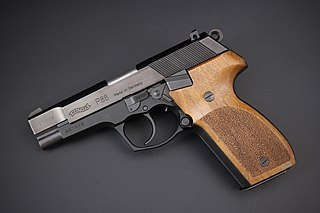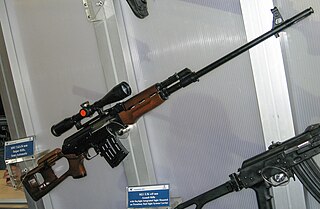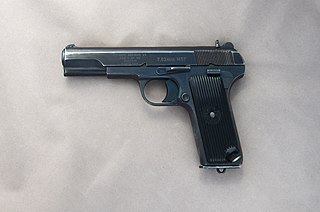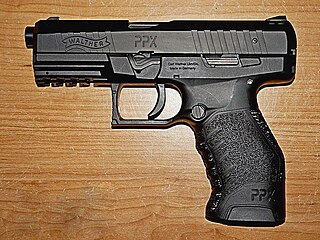
A revolver is a repeating handgun that has at least one barrel and uses a revolving cylinder containing multiple chambers for firing. Because most revolver models hold up to six cartridges, before needing to be reloaded, revolvers are commonly called six shooters.

The Browning Hi-Power is a single-action, semi-automatic pistol available in the 9×19mm Parabellum and .40 S&W calibers. It was based on a design by American firearms inventor John Browning, and completed by Dieudonné Saive at FN Herstal. Browning died in 1926, several years before the design was finalized. FN Herstal named it the "High Power" in allusion to the 13-round magazine capacity, almost twice that of other designs at the time, such as the Walther P38 or Colt M1911.

A derringer is a small handgun that is neither a revolver, semi-automatic pistol, nor machine pistol. It is not to be confused with mini-revolvers or pocket pistols, although some later derringers were manufactured with the pepperbox configuration. The modern derringer is often multi barreled, and is generally the smallest usable handgun of any given caliber and barrel length due to the lack of a moving action, which takes up more space behind the barrel. It is frequently used by women because it is easily concealable in a purse or a stocking.

The SIG Sauer P220 is a semi-automatic pistol designed in 1975 by the SIG Arms AG division of Schweizerische Industrie Gesellschaft, and produced by J. P. Sauer & Sohn, in Eckernförde. It is currently manufactured by both SIG Sauer companies: SIG Sauer GMBH, of Eckernförde, Germany; and SIG Sauer, Inc., of New Hampshire, United States.

The TT-30, commonly known simply as the Tokarev, is a Soviet semi-automatic pistol. It was developed in 1930 by Fedor Tokarev as a service pistol for the Soviet military to replace the Nagant M1895 revolver that had been in use since the Russian Empire, though it ended up being used in conjunction with, rather than replacing, the M1895. It served with the Soviet Armed Forces until 1952, when it was replaced by the Makarov pistol.

The Beretta M1951 is a 9×19mm semi-automatic pistol developed during the late 1940s and early 1950s by Pietro Beretta S.p.A. of Italy. The pistol was produced strictly for military use and was introduced into service with the Italian Armed Forces and other Italian security forces as the Modello 1951 (M1951), replacing the Modello 1934 pistol chambered for the 9×17mm Short cartridge.

The Zastava M76 is a military semi-automatic designated marksman rifle developed and manufactured by Zastava Arms.

In American English, a pocket pistol is any small, pocket-sized semi-automatic pistol, and is suitable for concealed carry in a pocket or a similar small space.

The Walther P88 is a semiautomatic pistol developed by German company Walther. Its main feature is a high-capacity double-stacked magazine designed for military and law enforcement use. The P88 was succeeded by the Walther P99 in 1997.

The Stechkin or APS is a Soviet selective fire machine pistol chambered in 9×18mm Makarov and 9×19mm Parabellum introduced into service in 1951 for use with artillery and mortar crews, tank crews and aircraft personnel, where a cumbersome assault rifle was deemed unnecessary. Seeing service in a number of wars such as the Vietnam War, Russo-Ukrainian War and Syrian Civil War. The APS was praised for its innovative concept and good controllability for its size. However, the high cost of the weapon, complex and time-consuming machining, combined with a limited effective range, large size and weight for a pistol, and fragile buttstock have been mentioned as a reason to phase it out of active service in favour of assault rifles such as the AKS-74U. The pistol bears the name of its developer, Igor Stechkin.

The Beretta M418 is an easily concealed Italian 6.35 mm pocket pistol. The earliest examples were made between 1919 and 1922. There are several versions, including the 1920, 1926, 1926 - 31, 1934, 318, and 418 models.

Zastava Arms is a Serbian manufacturer of firearms and artillery, based in Kragujevac, Serbia. In 1853, it was founded, and cast its first cannon. It is the leading producer of firearms in Serbia and is a large contributor to the local defense industry. Zastava Arms produces and exports a wide variety of products to over forty countries, including the Zastava M70, a Kalashnikov rifle.

The Zastava M91 is a semi-automatic designated marksman rifle chambered in 7.62×54mmR, developed and manufactured by Zastava Arms company in Kragujevac, Serbia. Like its predecessor, the Zastava M76, the M91 is internally based upon an elongated version of the AK-47 design, but the M91 shares more external similarities with the Dragunov sniper rifle than the M76. The rifle is in service with the Serbian army, where it replaced the M76, which was chambered for the 7.92×57mm cartridge.

The Zastava M77 B1 is a battle rifle developed and manufactured by Zastava Arms in Serbia. It was introduced in 1977. It is a derivative of the Zastava M70 and modified copy of the Soviet AKM chambered in 7.62×51mm with an enlarged receiver, and a Western-style flash suppressor. It is gas-operated, air-cooled, magazine-fed, selective fire battle rifle with a fixed wooden stock. The M77 AB1 has a folding stock. Early versions had a milled receiver and an adjustable gas block with flip up rifle grenade sights.

The Zastava M57 is a Yugoslavian and Serbian semi-automatic pistol produced by Zastava Arms. It was the standard service pistol of the Yugoslav People's Army from 1961 until the early 1990s. The M57 was an unlicensed derivative of the Soviet TT pistol, but incorporated a number of detail modifications, namely a longer grip and a slightly larger magazine. Zastava reverse engineered the Soviet TT in 1954, and began serial production of the weapon type as the M57 in 1963.

The Zastava M88 is a semi-automatic pistol produced by Zastava Arms, it is a compact redesign of the Zastava M57 pistol.

The Zastava M70, formerly designated CZ M70 is a semi-automatic pistol produced by Zastava Arms as a sidearm for Yugoslav police and certain military officers. The pistol was loosely based on the Zastava M57, but is scaled down to accept the smaller and less powerful 7,65mm Browning or 9mm Kratak.
The Zastava PAP are a series of Serbian sporting rifles based on the Zastava M70 and Zastava M77B1. They are nearly identical to their military counterparts, but lack select-fire capability and have been modified with a number of sporting features designed to comply with firearms imports laws in the United States, where they are primarily marketed.

The Zastava CZ99 is a semi-automatic pistol produced by Zastava Arms. It was developed in 1989 to replace the M57 in the Yugoslav military and police. The CZ99 is primarily chambered in 9×19mm Parabellum with a 15-round magazine, although .40 Smith & Wesson variants also exist, with ten-round magazines.

The Walther PPX and the Walther Creed semi-automatic pistols were developed by the German company Carl Walther GmbH Sportwaffen of Ulm as low-cost duty handguns. The PPX was available in 9×19mm Parabellum and .40 S&W. Its successor, the Creed, was available only in 9mm.


















